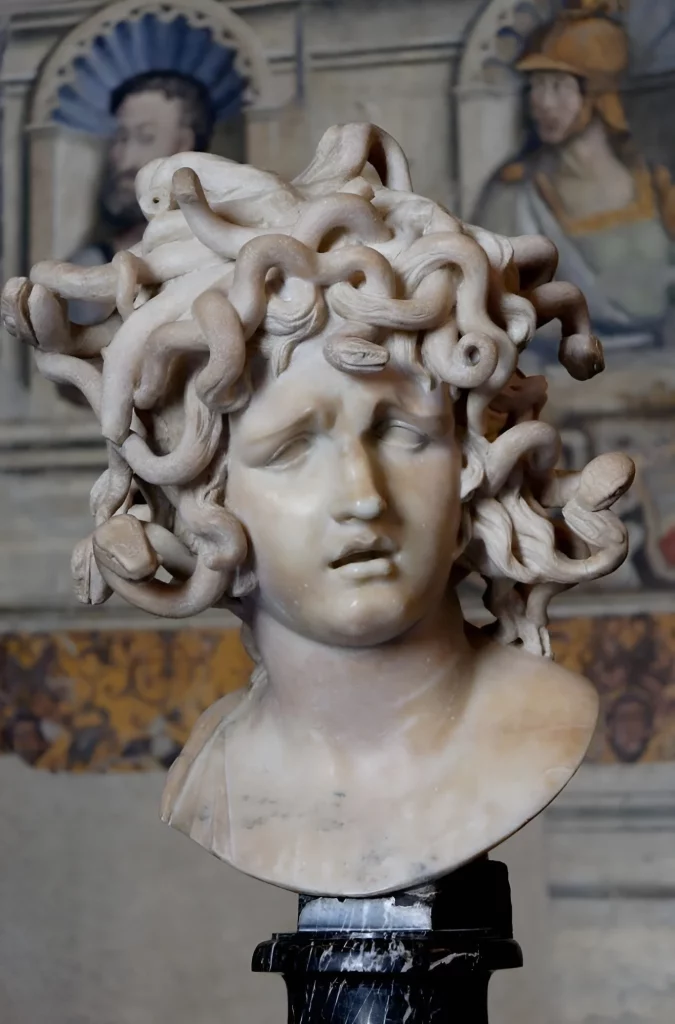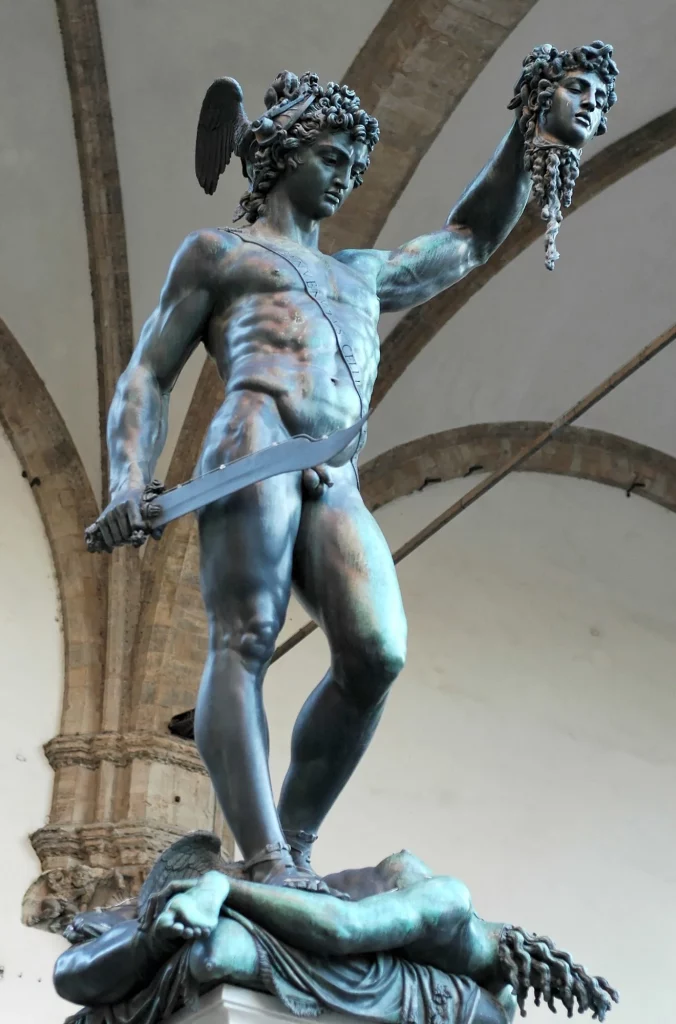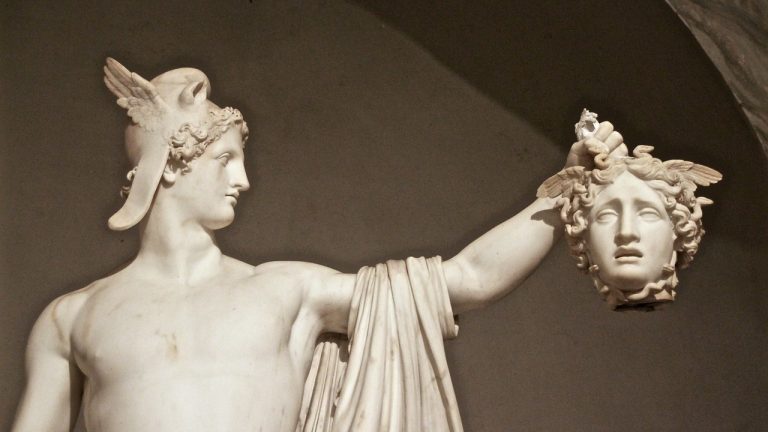Medusa with her snake hair and fierce eyes is one of the most emblematic mythological figures of the Greek world. Although she occupied a secondary place in the imaginary of gods and heroes, her character has remained to this day, as she has been represented countless times in art, literature and cinema.
Over time, he has experienced various facets. From a horrifying monster, she went on to represent women’s sexuality and became an icon of feminist movements.

Where does Medusa come from?
There are two versions about her origins. The first says that Medusa was the daughter of the sea gods Forcis and Ceto. Together with her sisters Steno and Euryale, they formed the trio of gorgons, monsters that terrorized by their terrible appearance and were capable of petrifying anyone with their gaze.
The Greek poet Hesiod is the first to mention them in his famous work Theogony, where he relates them to the underworld as creatures that inhabit the ends of the earth.
… and the Gorgons that live on the other side of the illustrious Ocean, at the edge of the world towards the night, where the sharp-voiced Hesperides: Steno, Euryale and Medusa…
In this story Medusa is described as hapless and it is mentioned that, unlike her sisters, she was mortal. Reference is also made to the sexual relationship she had with the “bluish-haired” one, who can be inferred to be Poseidon, god of the sea.
Then, in the play Prometheus in Chains by Aeschylus (525 – 456 B.C.), they are mentioned as:
Aligerous sisters, with the hair of serpents, the Gorgons, hateful to men … the mortal who looks at them will not retain the breath of life.
For his part, in The Greek Myths, the writer Robert Graves focuses only on Medusa and describes her in the following terms:
The Gorgon Medusa had snakes for hair, huge teeth, a hanging tongue and, in general, a face so ugly that everyone who looked at her was petrified with fear.
This terrible character led to the fact that in antiquity the gorgons became protectors called Gorgoneion. Thus, they were used as an apotropaic device, that is, a magical or supernatural defense mechanism. Thus, their faces were used on ceramics and on the front of temples to ward off evil.
The second version is found in The Metamorphosis (8th century A.D.) by Ovid. There she is described as a beautiful maiden who stood out for her beautiful hair. Although she was surrounded by suitors, she decided to become a priestess of Athena, goddess of wisdom and war. However, Poseidon fell in love with her and raped her in the same temple.
This situation infuriated Athena and she decided to punish Medusa, turning her into a hideous monster, with hair like snakes and eyes that turned to stone anyone who dared to look at her.
Myth of Perseus
King Acrisius had a daughter named Danae. When he consulted the oracle of Delphi about the possibility of having a male heir, he knew that one day his grandson would kill him. Because of this, he decided to build a place away from the world so that his daughter would have no contact with men.
However, Zeus fell in love with her and snuck into her captivity in the form of a shower of gold, giving birth to Perseus. When Acrisius learned that a child had been born, he banished them by throwing them into the sea in a basket.

Although they were swept away by the current, they managed to survive and reached the island of Seriphos, where they were welcomed and cared for by Dictis. Years went by and all was going well until King Polydectes began to lust after Danae and noticed that Perseus was an over-zealous and over-protective son. So, he plotted a deception to convince the young man to bring him the head of Medusa, a task from which he would surely not come out alive.
Perseus decided to face the challenge with courage, so Athena and Hermes wanted to help him. Thus, they guided him to some nymphs who could provide him with what he needed for his adventure.
He was then given winged sandals to reach the home of the gorgons, the cap of Hades that would grant him invisibility and a metallic backpack (kibisisis) to keep his head. In addition, Hermes gave him an adamantium sickle (ultra-resistant mythical material) and Athena a shiny shield like a mirror.
With all these implements he went to where the gorgons lived and while they slept, he cut off Medusa’s head, taking care to look away so as not to fall prey to his spell. At that instant, from her head emerged – already grown – her children with Poseidon: Pegasus and Chrysaor.
His sisters tried to take revenge on the murderer, but thanks to the helmet he was able to flee without being seen. After his success, he returned home. Medusa’s head still retained its powers, so she used it against her enemies until she gave it to Athena, who placed it in the center of her shield to terrorize her opponents.
Feminist claim
Over the years, Medusa remained a character of Greek mythology associated with the myth of Perseus. However, the 20th and 21st centuries completely transformed her image.
In 1975, Hélène Cixous, one of the most important feminist theorists, published Medusa’s Laughter. In this book, she argues that men have constructed a monstrous feminine vision, due to the fear they feel for desiring women. For the philosopher, if they dared to look at Medusa directly, they could see that in reality she is not deadly, but beautiful and that she laughs.
Then, it gained relevance again in the wake of the #Metoo movement. In Ovid’s version, Medusa was punished after being raped. This idea of blaming and shaming victims resonated with several women who decided to make Medusa their standard.
In 2018, Argentine artist Luciano Garbati created a two-meter high bronze statue that was installed outside the courthouse that convicted film producer, Harvey Weinsten of harassment and abuse.

The creator decided to take inspiration from the famous sculpture by Benvenuto Cellini in Florence, which shows Perseus holding Medusa’s head as a trophy. Thus, here the roles are reversed and it is Medusa who holds Perseus, showing a defiant and empowered attitude.
Although it became a trend, it was not exempt from criticism. It was judged by several factors, among them that the author was a man, that it had no pubic hair and that the head was of Perseus and not of the rapist Poseidon.
Medusa in popular culture
Medusa has become a recognized figure in the popular imagination. Unlike the ancient vision in which she was considered a monster, nowadays her sensuality and power are rescued.
For example, in 2010 two films were released in which she stood out. In Fury of Titans, Russian model Natalia Vodianova played the Gorgon. Then in Percy Jackson and the Lightning Thief featured actress Uma Thurman portraying Medusa. While the snake hair is respected, what stands out most about the character is her beauty and attractiveness.
On the other hand, in 2013 the English GQ magazine decided to celebrate its 25th anniversary with the singer Rihanna on its cover. There she was portrayed as Medusa with her hair of snakes and a stony look, where what stood out the most was the eroticism.
The photo shoot was in charge of the renowned artist Damien Hirst, who chose to play with the idea of the femme fatale who is able to conquer whoever looks at her.




